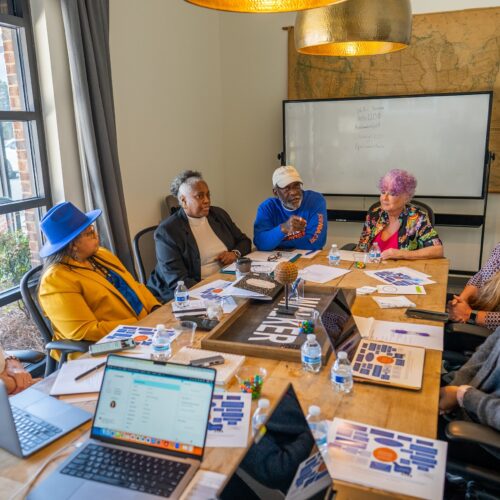Roadmap Released to Improve Outcomes for Youth in Juvenile Justice System
WASHINGTON, D.C. — Members of Congress, the U.S. Department of Justice (DOJ), and others met with juvenile justice leaders during separate events recently to discuss two publications released by the Council of State Governments Justice Center (CSG Justice Center), which offer state and local governments recommendations to improve outcomes for youth who come into contact with the juvenile justice system.
“The research done in this field by the Council of State Governments Justice Center has really been a game-changer,” said U.S. Sen. Chris Murphy, D-CT, from the July 28 briefing on Capitol Hill that also featured remarks from U.S. Sen. Sheldon Whitehouse, D-RI.
The first publication, Measuring and Using Juvenile Recidivism Data to Inform Policy, Practice, and Resource Allocation, surveyed all 50 states’ juvenile correctional agencies and found 20 percent of those agencies do not track the rates of youth reoffending. Of the 39 states that do track recidivism data, most consider only one type of contact with the justice system, stopping short of determining, for example, whether the youth was later incarcerated in the adult system.
There has been significant progress in juvenile justice reform, with youth confinement rates almost cut in half from 1997 to 2011, and juvenile arrest rates in 2011 at their lowest level in more than 30 years. But as lower-risk youth have successfully been redirected from incarceration, progress is still needed to track, and ultimately improve, the outcomes of those higher-risk youth and others previously under supervision.
“Even with all of that success, we’re here because 60,000 young people are still confined in juvenile detention and corrections facilities on any given day,” U.S. Associate Attorney General Tony West said during a morning meeting of the DOJ’s Coordinating Council on Juvenile Justice and Delinquency Prevention. “When they are released, they will need support to help them successfully make that transition to adulthood.
“With all of these policy discussions we’re having, and the interagency conversations, there are actual young lives that depend on the folks around this table getting it right.”
The CSG Justice Center also released Core Principles for Reducing Recidivism and Improving Other Outcomes for Youth in the Juvenile Justice System, a white paper that offers guiding principles and recommendations based on what’s been proven to work. Those recommendations, which range from engaging family in decisions regarding a child, to moving away from tactics such as curfew laws and “scared straight” programs, are also offered with concrete examples of states that have succeeded by employing these strategies.
“We now have the tools, we have the knowledge and we have the experience,” said Laurie Garduque, director of Justice Reform at the John D. and Catherine T. MacArthur Foundation. “We think that it’s time now that leadership, both at the federal government and the local government, demand that we have better outcomes for our young people.”
The CSG Justice Center also announced partnerships with five states to test the implementation of the recommendations outlined in the reports: Utah, Tennessee, Nebraska, Kansas, and Pennsylvania.
“We can talk about the programs, services, and treatment we provide, but good intentions alone won’t reduce the likelihood of reoffending,” said Susan Burke, director of the Utah Division of Juvenile Justice Services. “This white paper released today summarizes, in one comprehensive document, the new lens in which we should be viewing each state system. I, for one, am eager to get started.”
A positive school experience, where a child feels secure, is essential for their well-being. However, for many children…
Read MoreWhen returning to their communities from criminal justice settings, people with behavioral health needs face barriers in accessing…
Read More Supporting Children of Incarcerated Parents: Reimagining School and Community Collaboration
Supporting Children of Incarcerated Parents: Reimagining School and Community Collaboration
A positive school experience, where a child feels secure, is essential for…
Read More Bridging Communities and Correctional Systems: Q&A with CSG Justice Center Advisory Board Member Commissioner Nicholas Deml
Read More
Bridging Communities and Correctional Systems: Q&A with CSG Justice Center Advisory Board Member Commissioner Nicholas Deml
Read More
 Assigned to the Cloud Crew: The National Incarceration Association’s Hybrid Case Management for People with Behavioral Health Needs
Assigned to the Cloud Crew: The National Incarceration Association’s Hybrid Case Management for People with Behavioral Health Needs
When returning to their communities from criminal justice settings, people with behavioral…
Read More Meet the Medicaid and Corrections Policy Academy Mentor States
Meet the Medicaid and Corrections Policy Academy Mentor States
New Hampshire Department of Corrections Commissioner Helen Hanks presents at the Medicaid…
Read More Taking the HEAT Out of Campus Crises: A Proactive Approach to College Safety
Taking the HEAT Out of Campus Crises: A Proactive Approach to College Safety
The sharp rise in school shootings over the past 25 years has…
Read More










